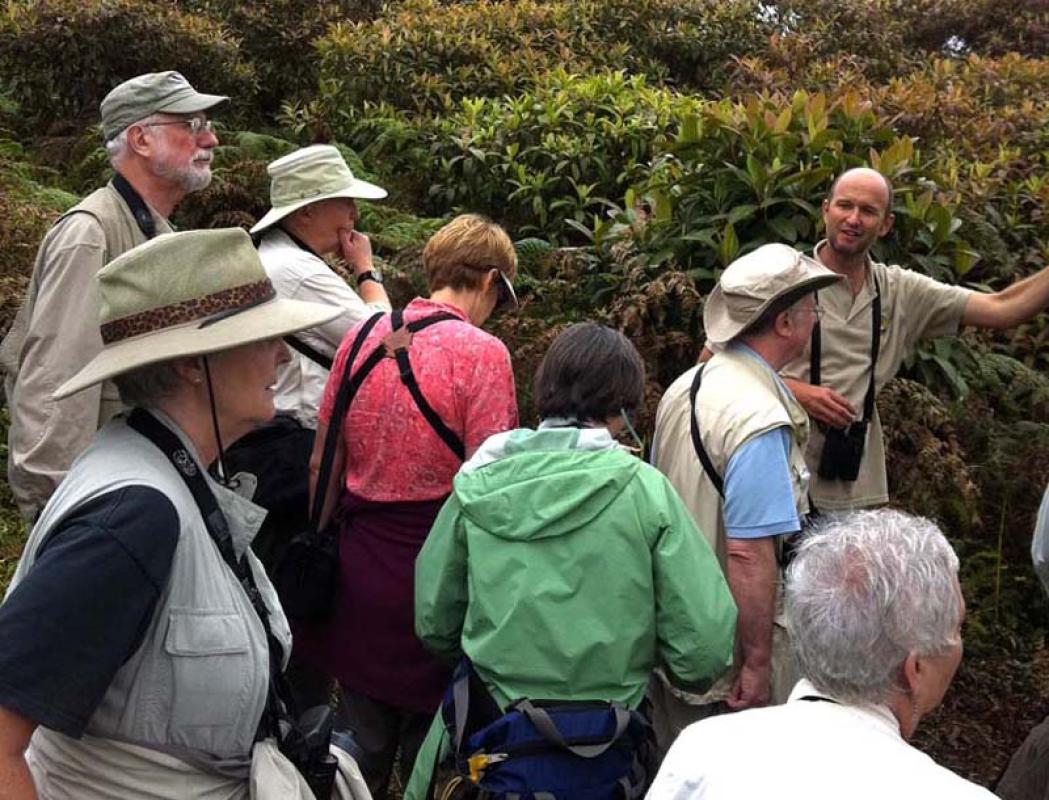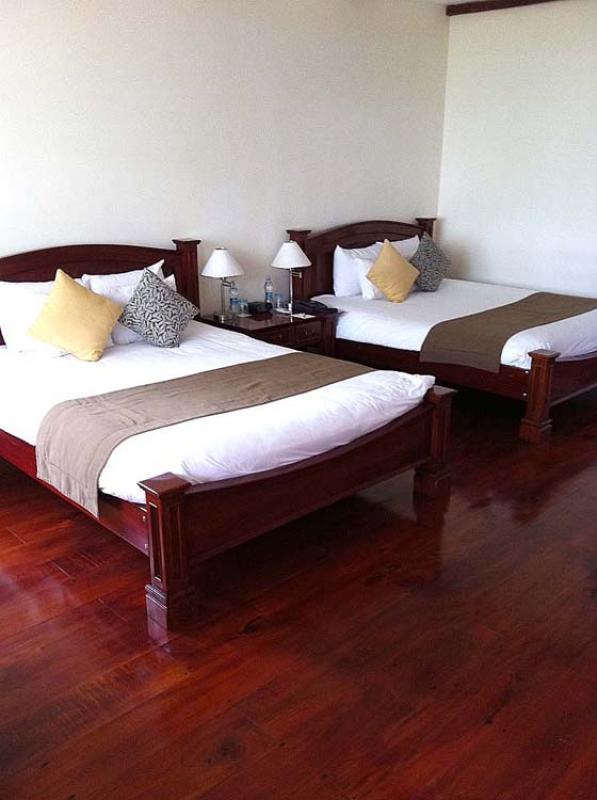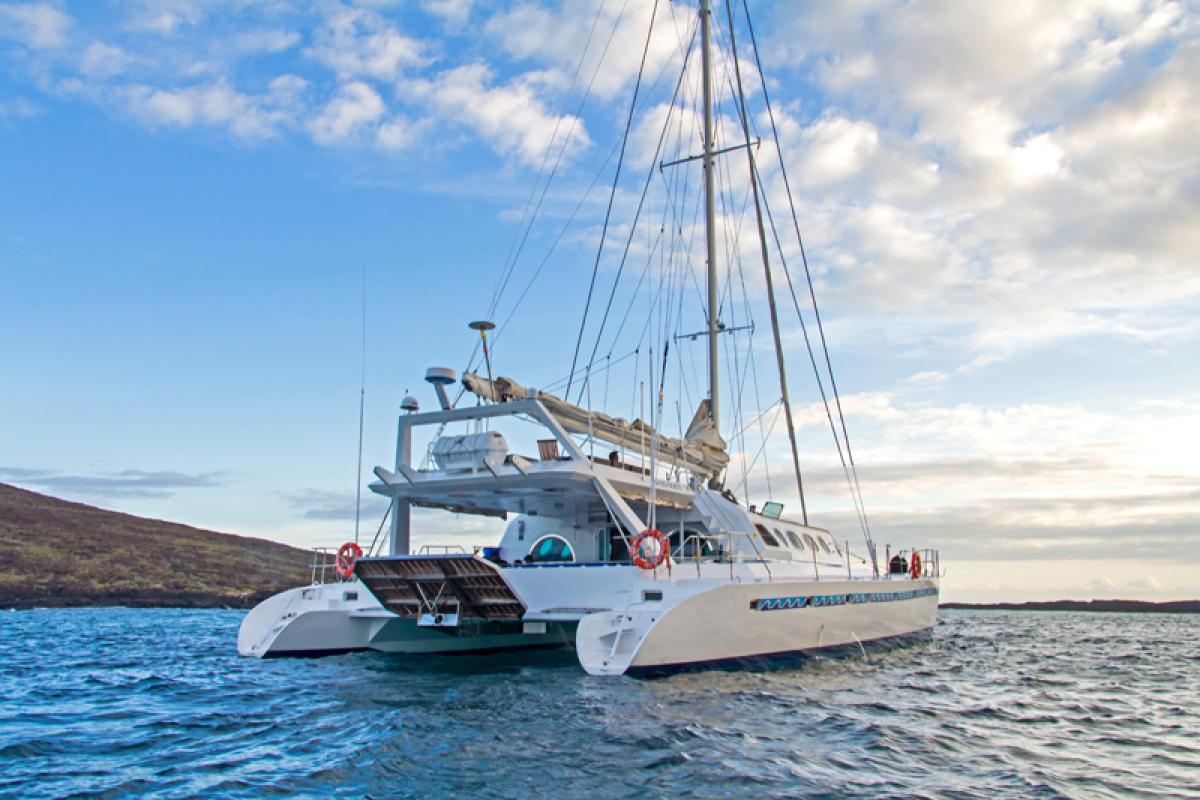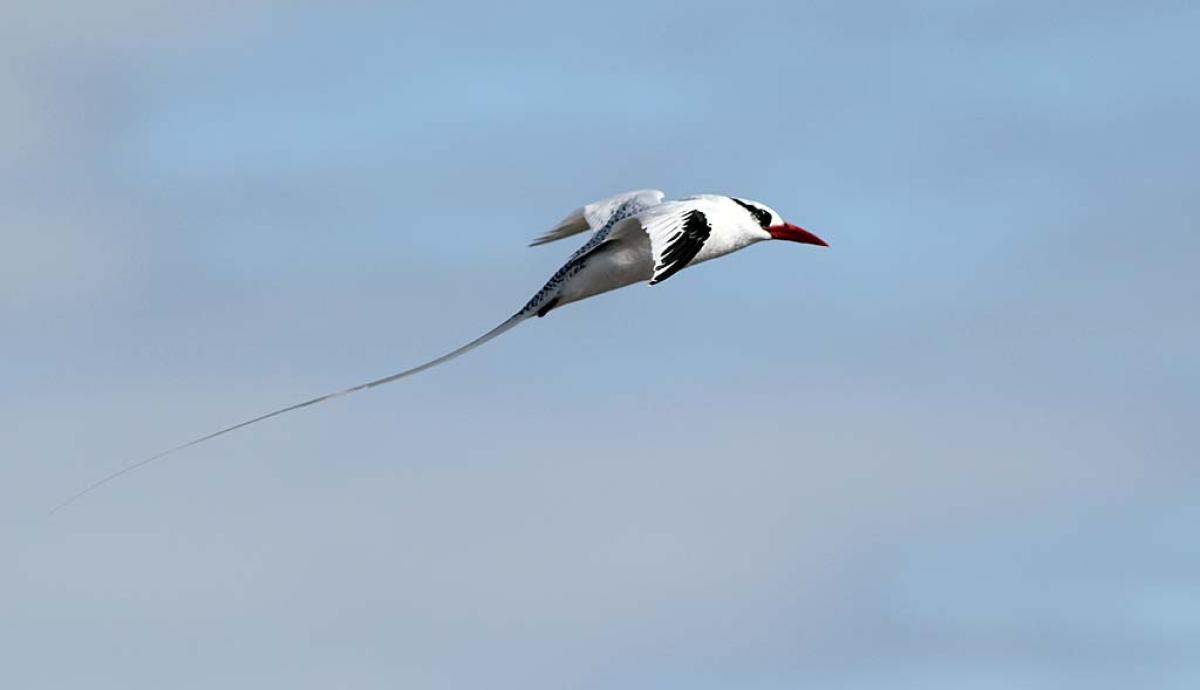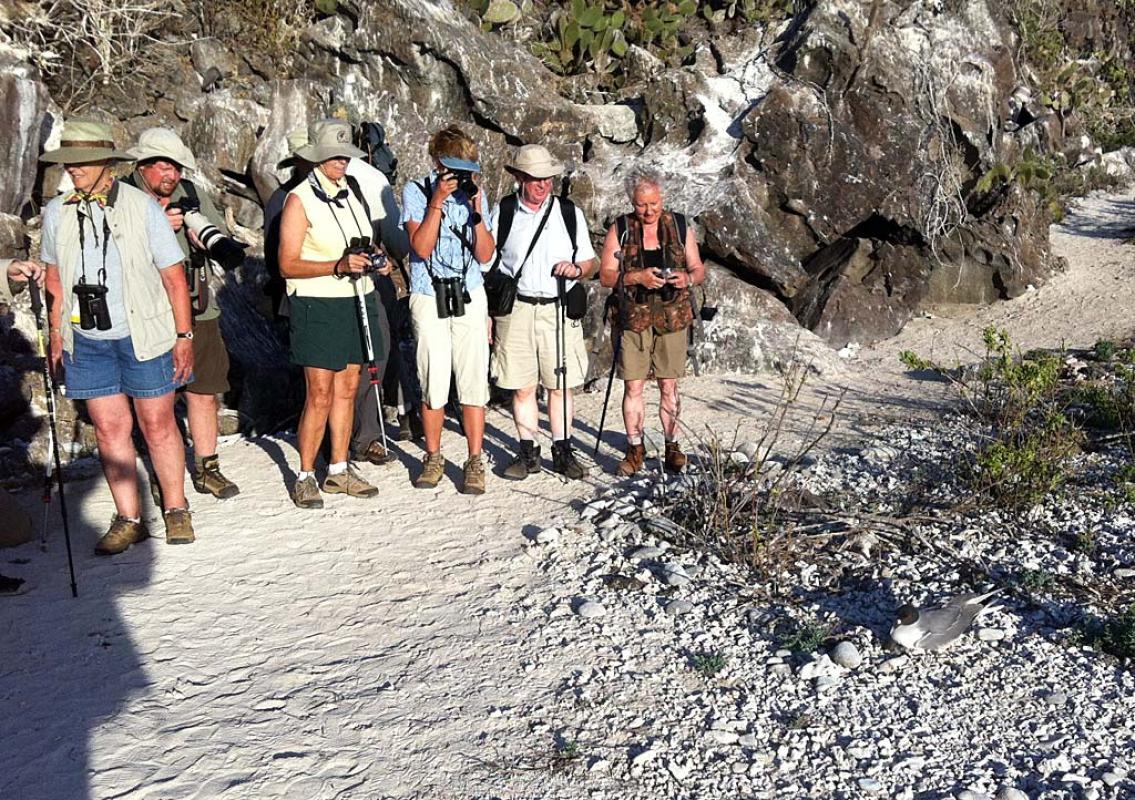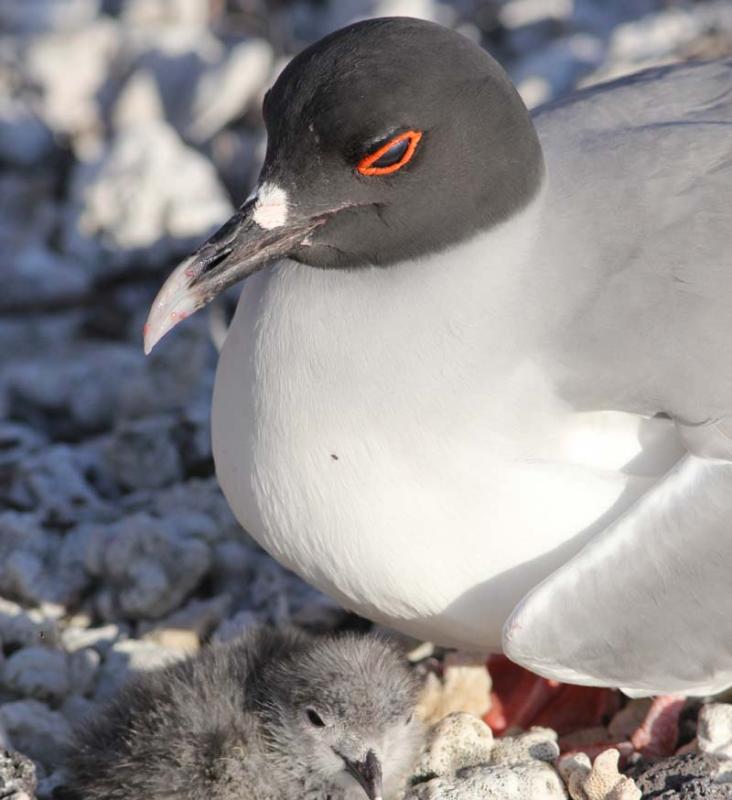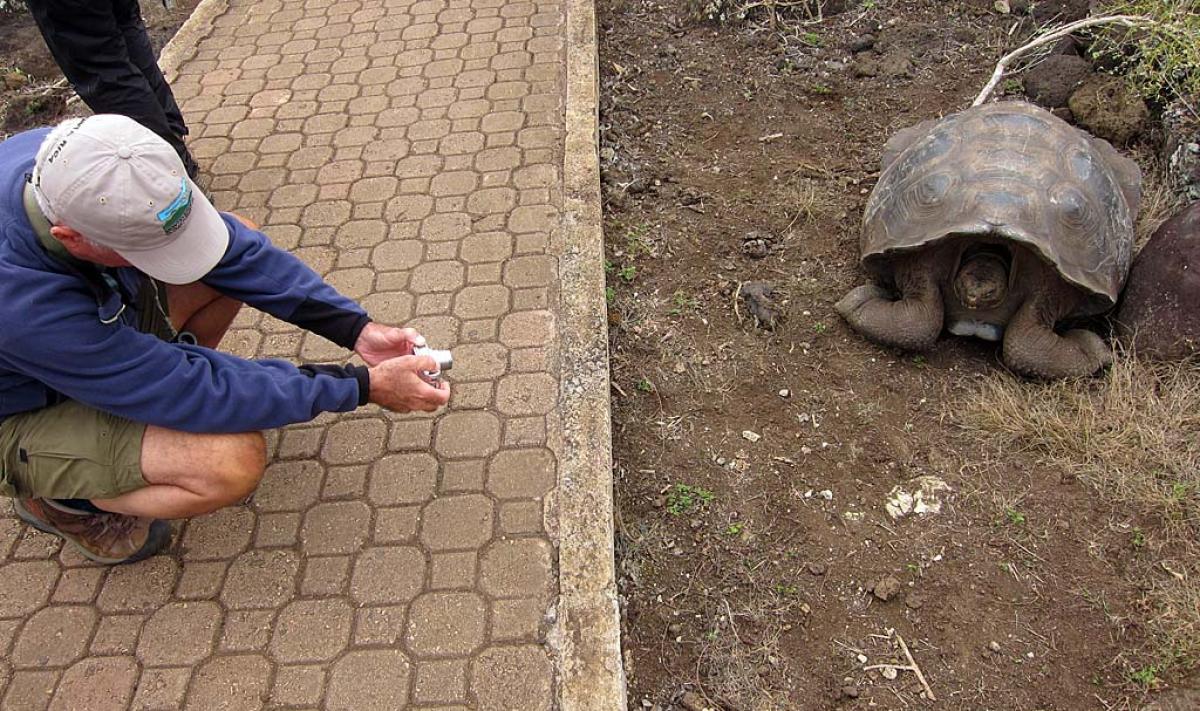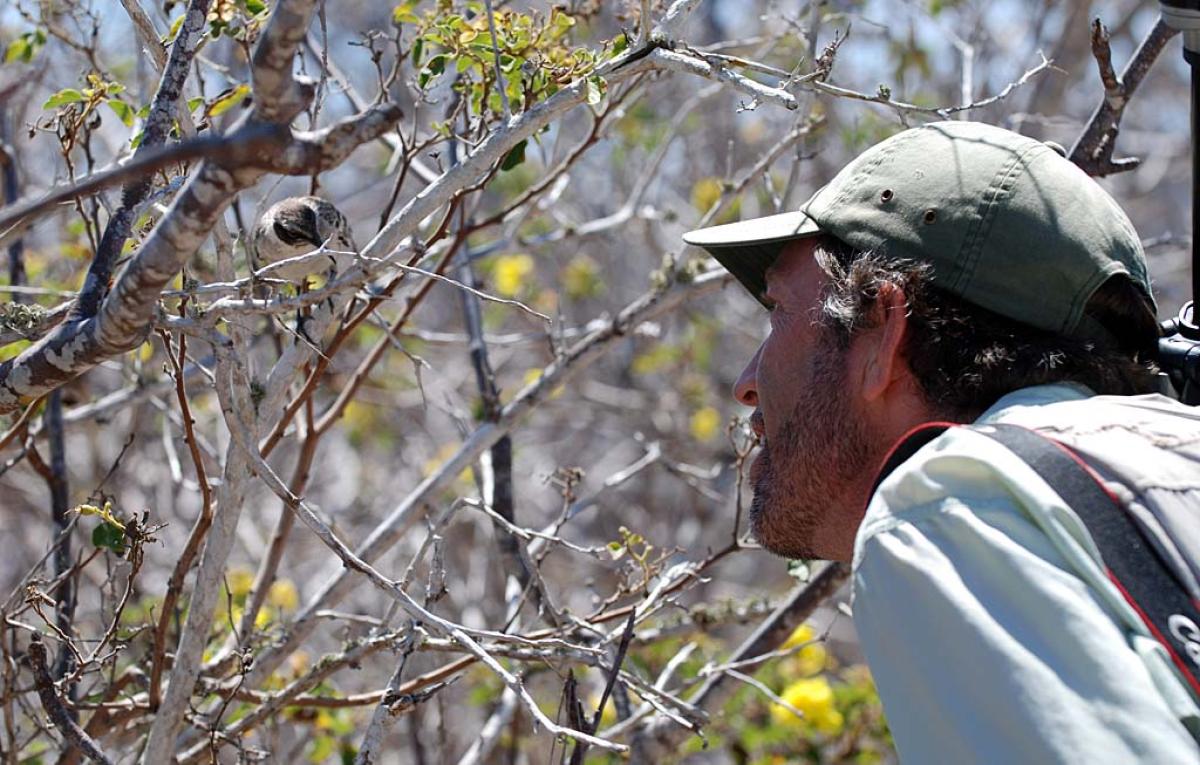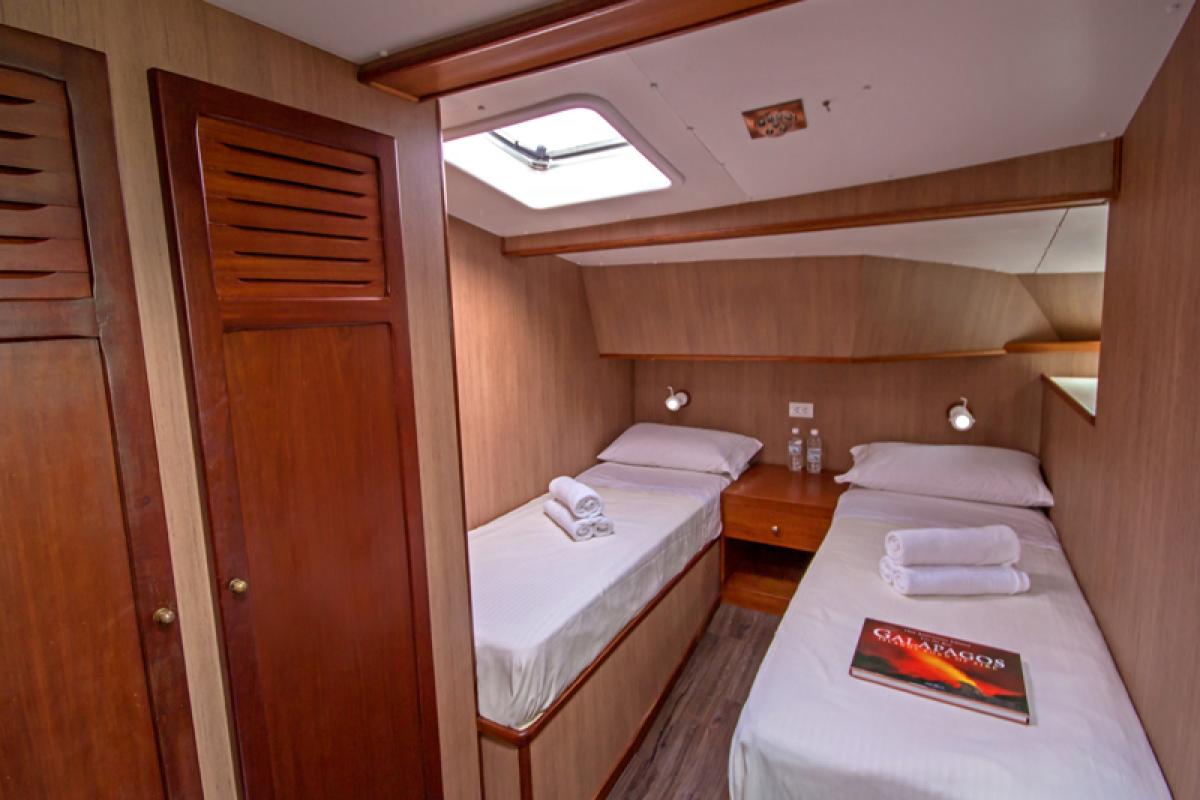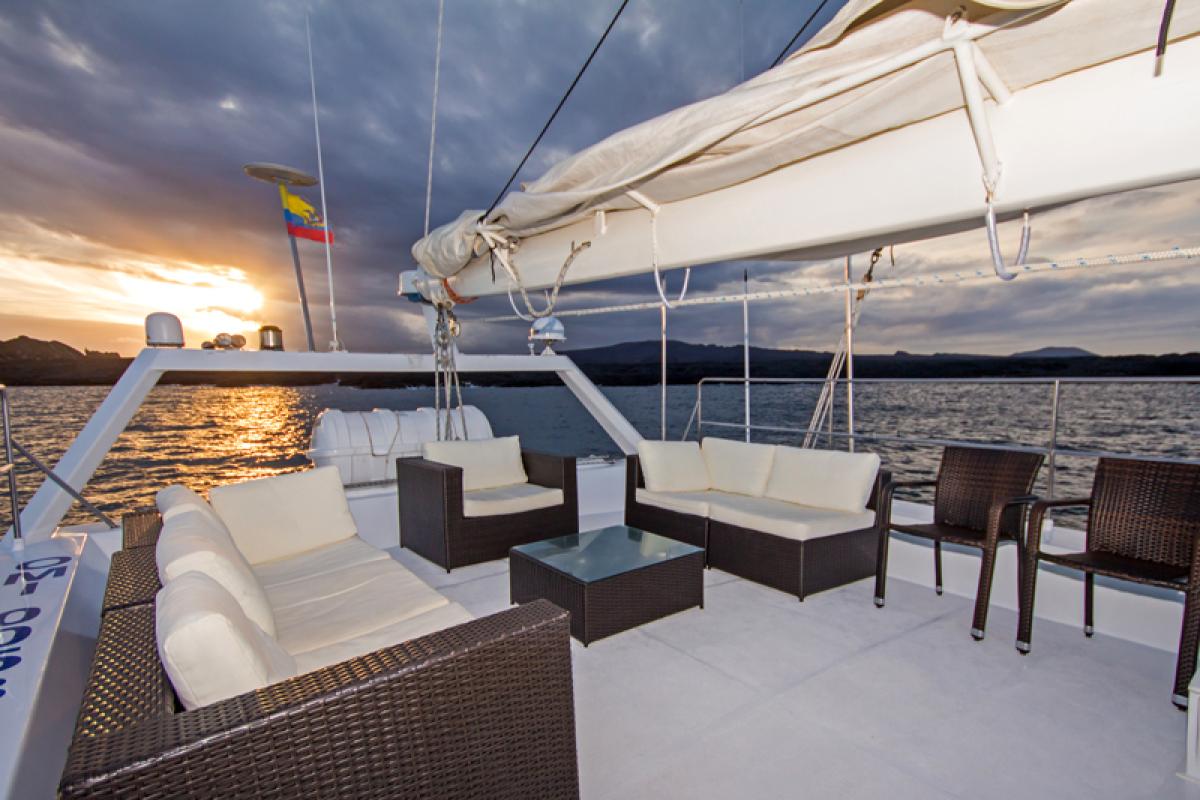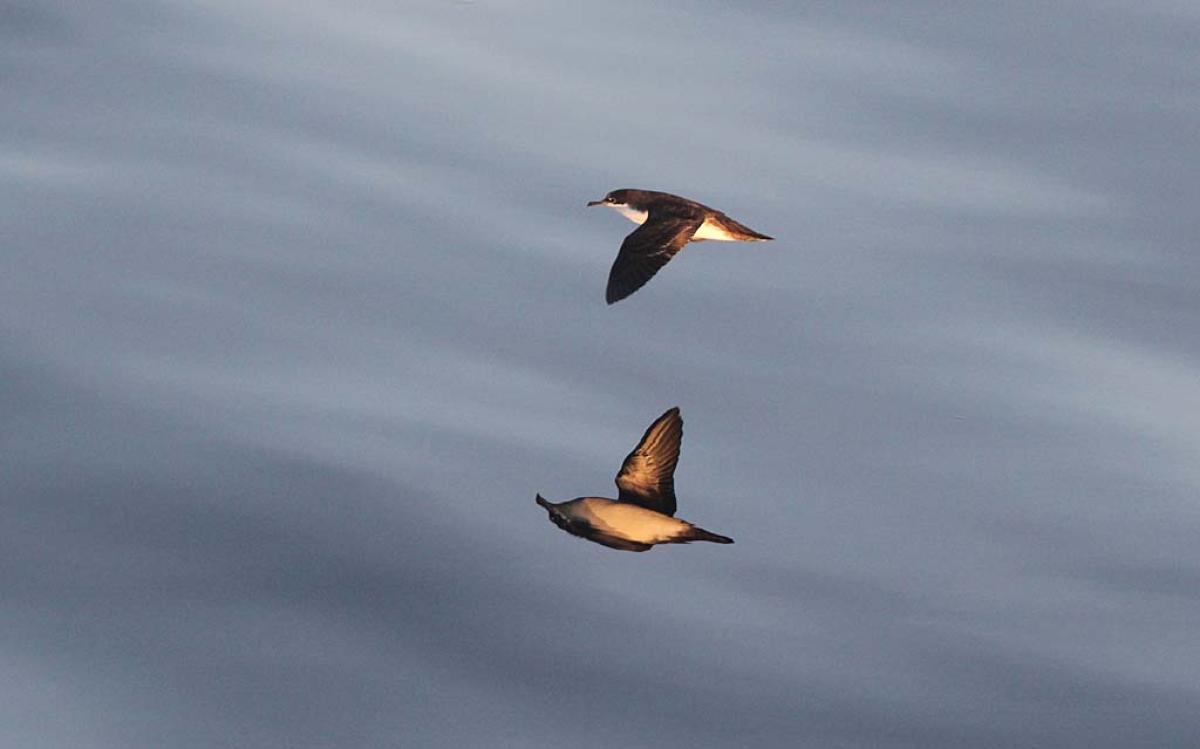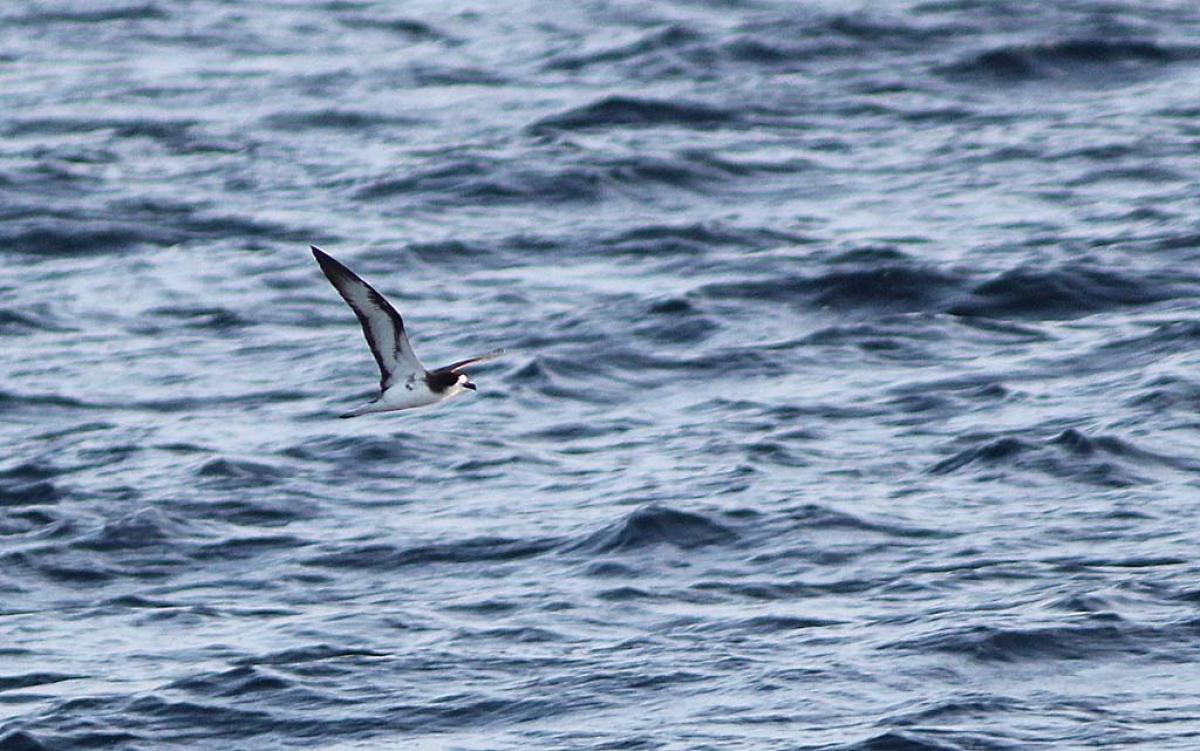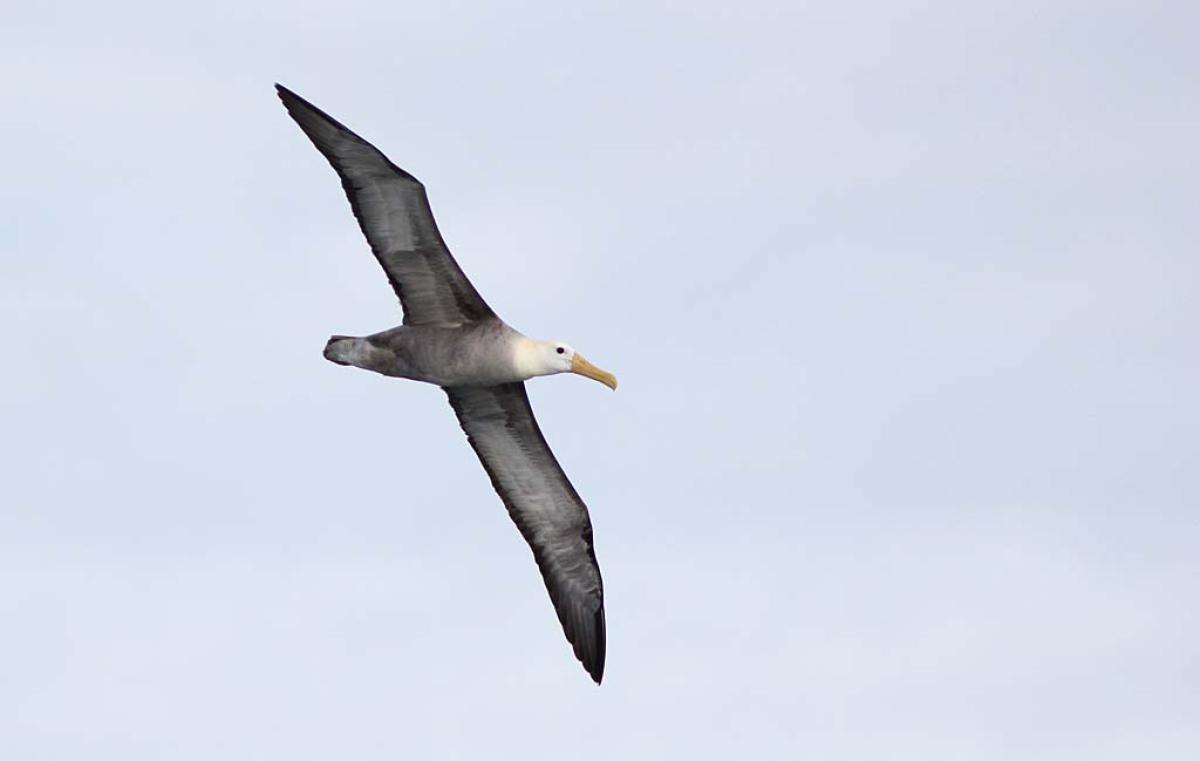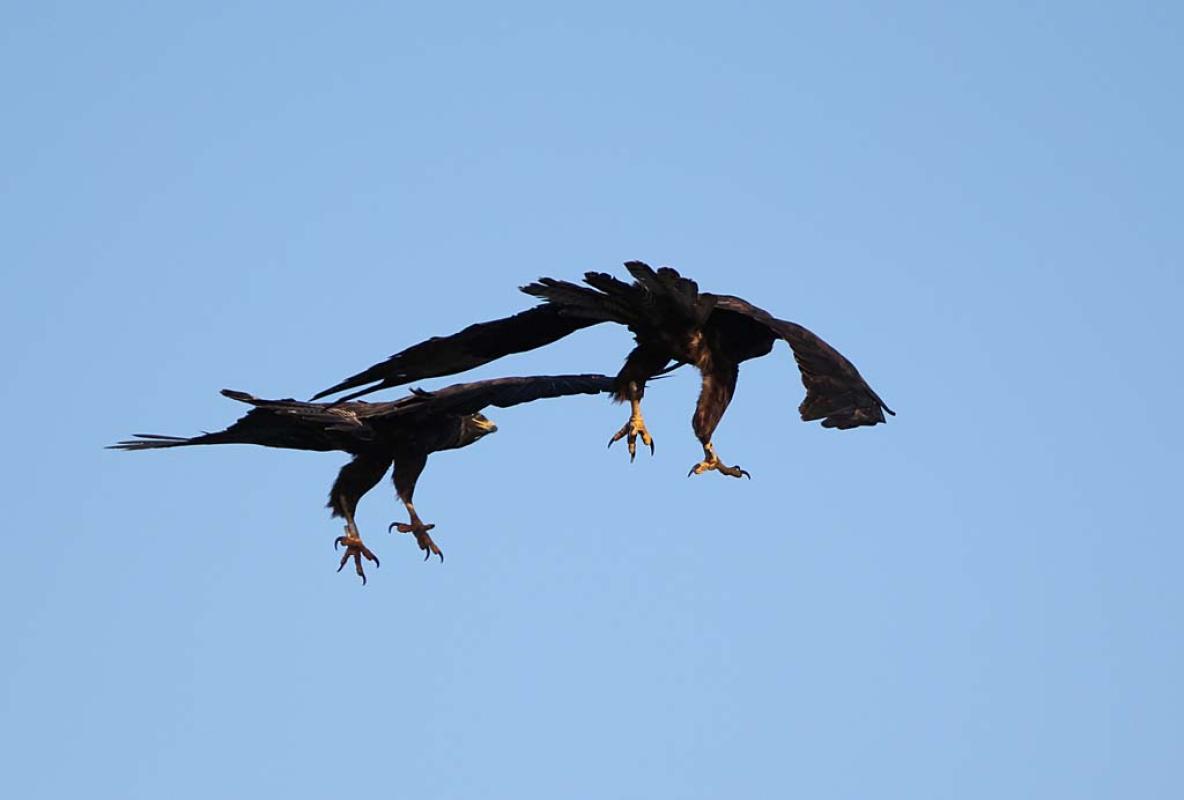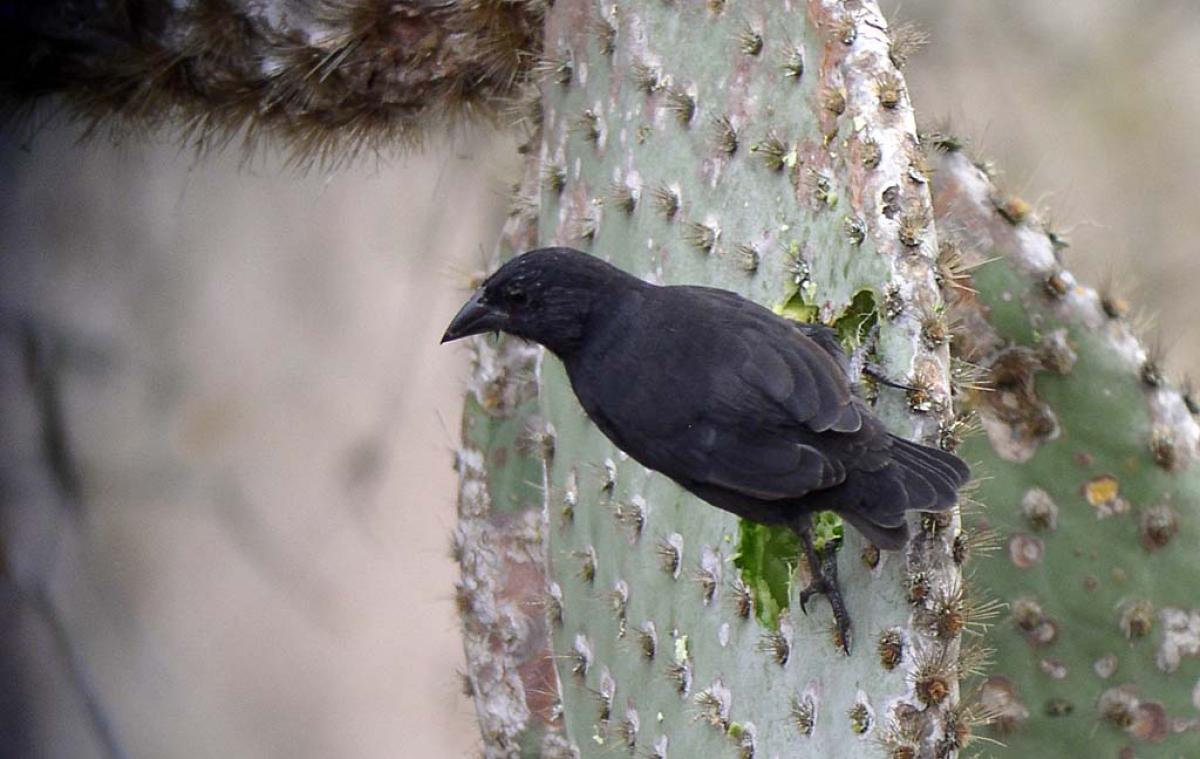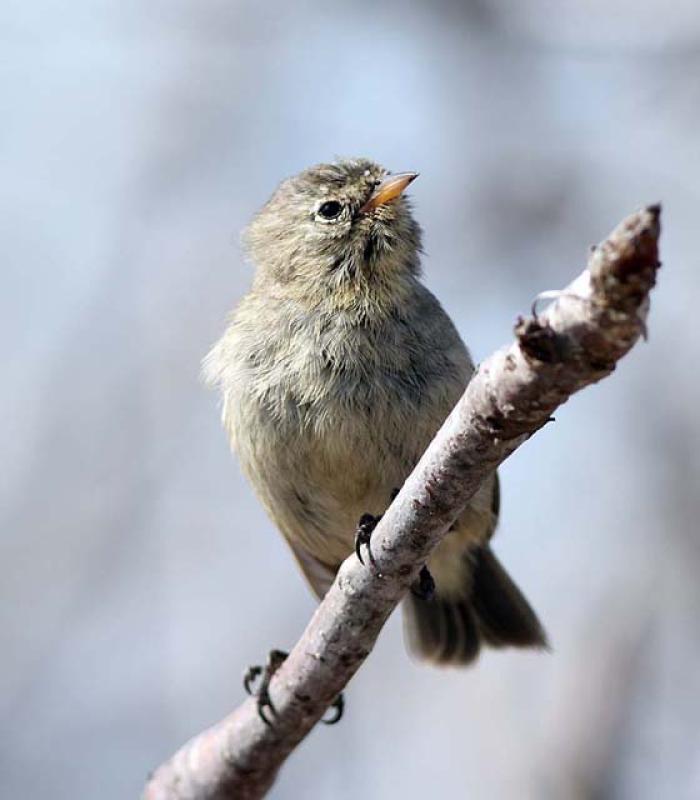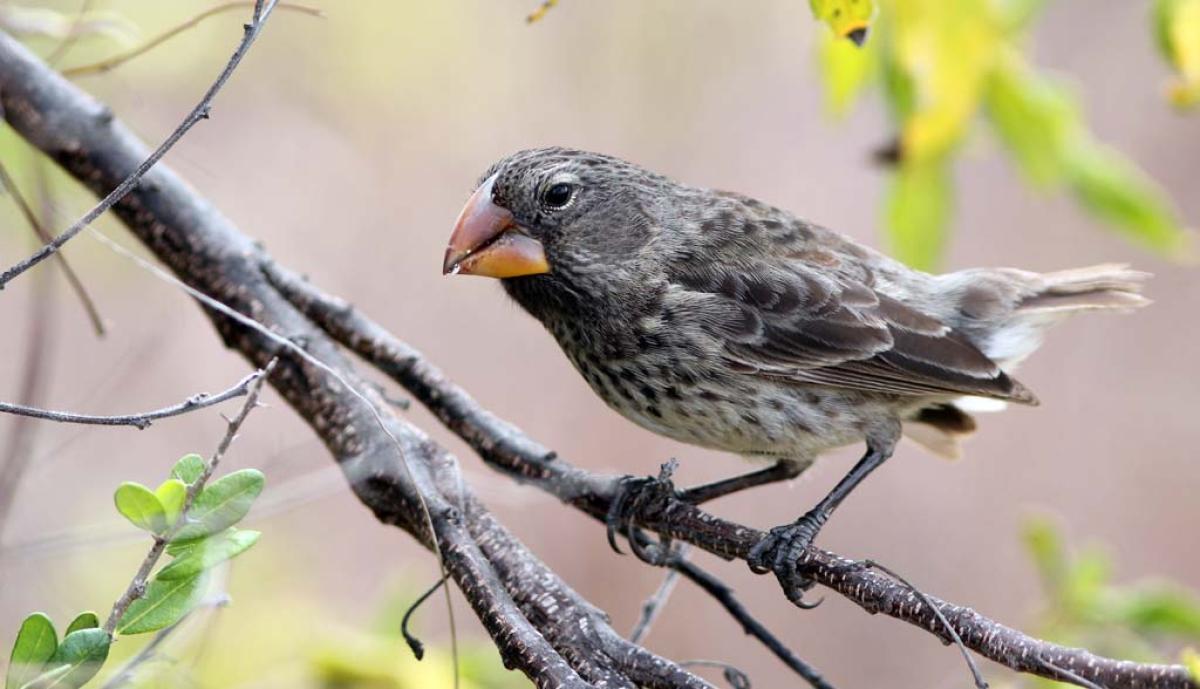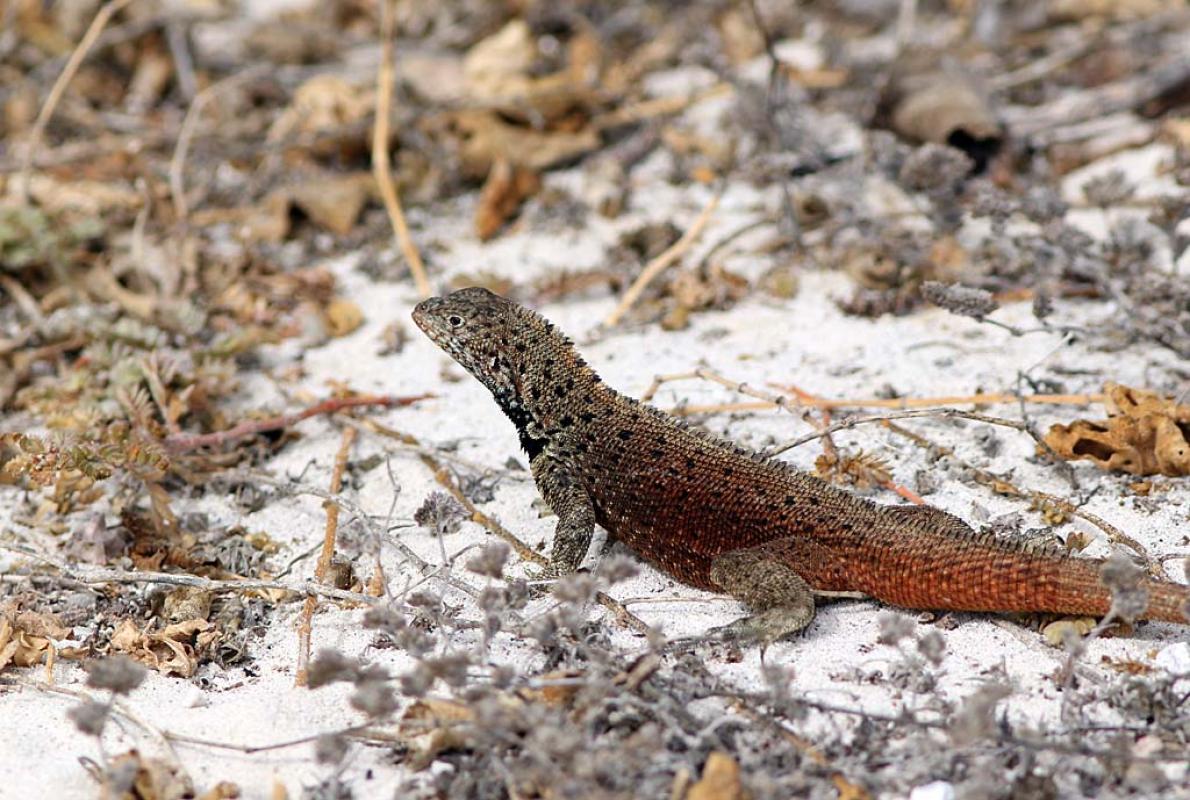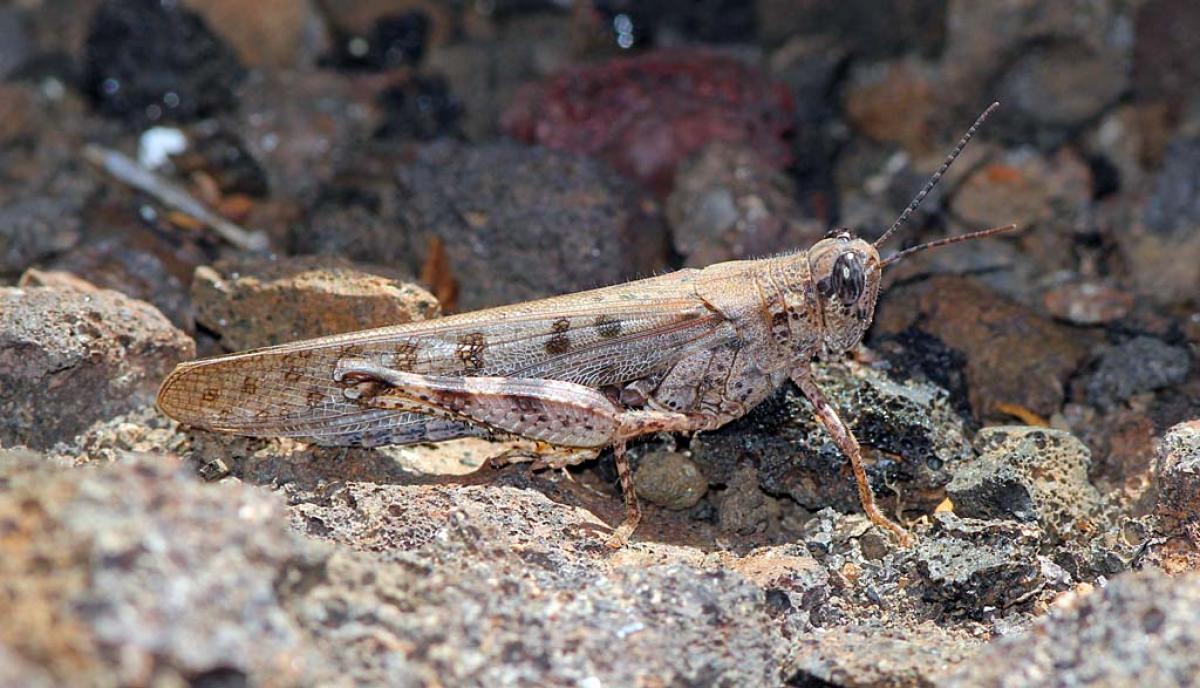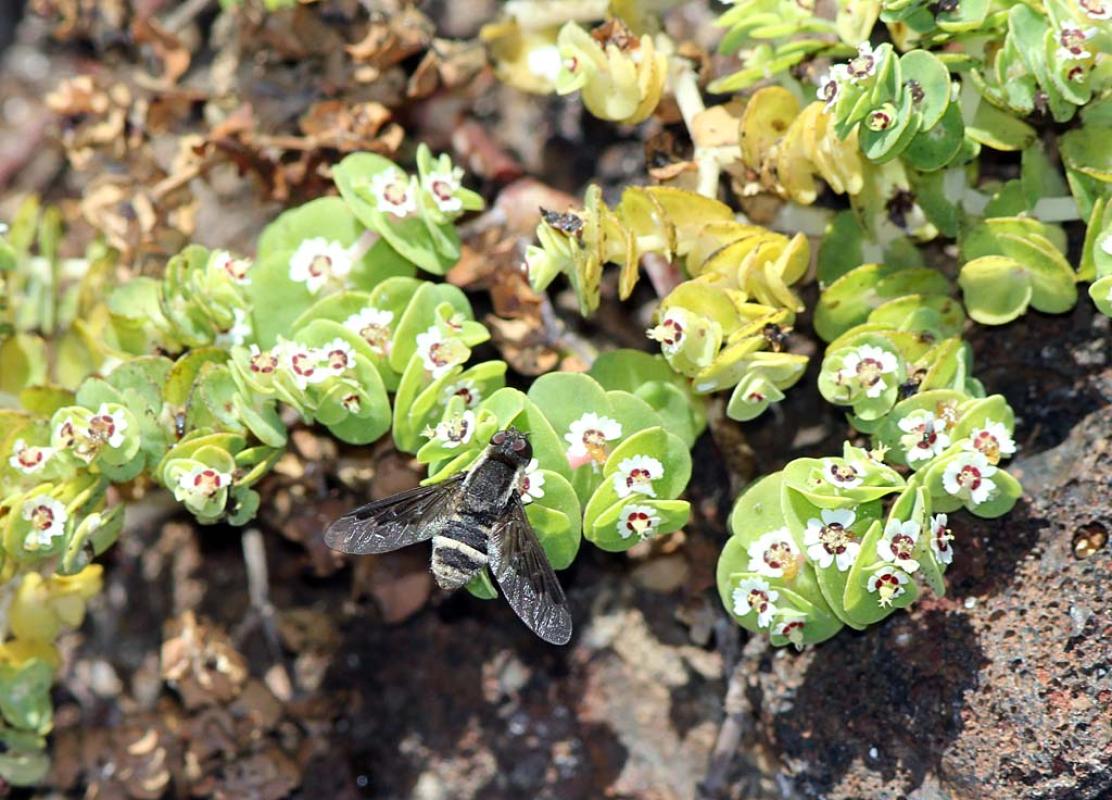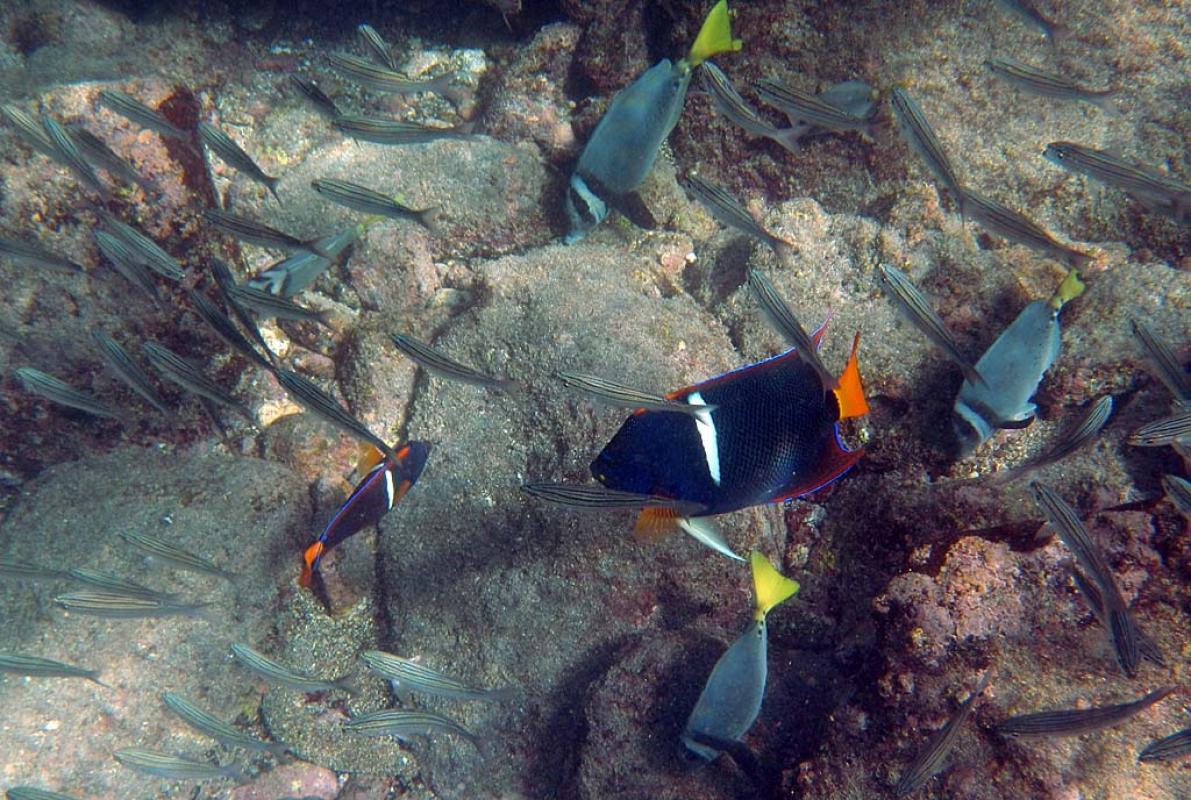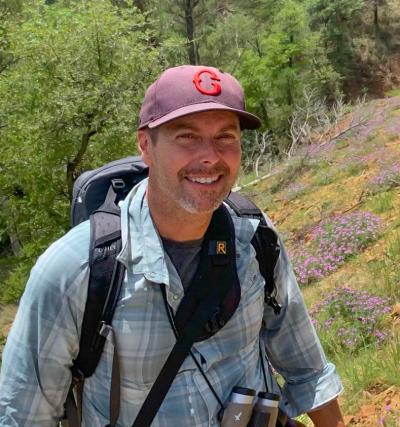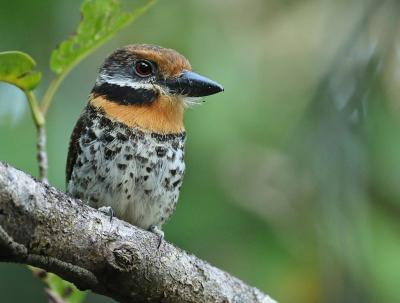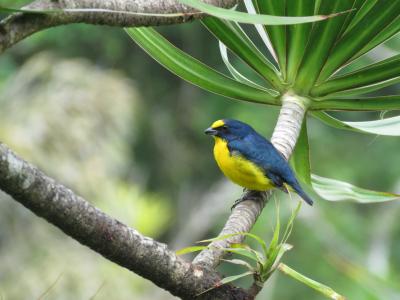The Galápagos Islands
-
Nov 15-25, 2024
Rich Hoyer
-
May 29 to Jun 8 2026
Rich Hoyer
2026 Tour Price to be Determined
2026 Tour Price to be Determined
The Galápagos Islands were born out of the bowels of the earth millions of years ago as intense volcanic activity spewed forth lava and buckled the seabed. The resulting archipelago, some 600 miles off the coast of Ecuador, now straddles the equator, scattered far and wide by the slow movement of tectonic plates within the earth’s crust. This isolation, from both continental South America and each other, has given each island a unique character. As wildlife colonized the islands, it began a process of adaptation to the specific conditions, and Charles Darwin’s observations here during his voyage on the Beagle helped crystallize his epic theory. Today one can still see virtually all the creatures Darwin did—a mind-boggling array of fascinating, fearless, and endemic birds and other animals.
Visits to the Galápagos are carefully controlled by the Ecuadorian government, and though the restrictions keep prices high, they also ensure that only a very limited number of boats can visit at one time. We’ve chartered a fine boat, the sea catamaran Nemo III, following an itinerary with natural history exploration in mind. In addition to seeing as many of the endemic birds as we can (among which are a couple of gulls, 14 of the 17 finches, two flycatchers, four mockingbirds, a dove, a penguin, a cormorant, a rail, and a martin), we’ll have plenty of chances to spend time with the storied seabirds, sea lions, and marine iguanas, as well as the many other endemic species worth looking for, including lizards, a few small snakes, a butterfly, a dragonfly, and even a scorpion and a few spiders, moths, and others. We’ll also have almost daily opportunities for snorkeling among the abundant sea life, from schools of colorful fish to sea turtles.
The Galápagos Islands were born out of the bowels of the earth millions of years ago as intense volcanic activity spewed forth lava and buckled the seabed. The resulting archipelago, some 600 miles off the coast of Ecuador, now straddles the equator, scattered far and wide by the slow movement of tectonic plates within the earth’s crust. This isolation, from both continental South America and each other, has given each island a unique character. As wildlife colonized the islands, it began a process of adaptation to the specific conditions, and Charles Darwin’s observations here during his voyage on the Beagle helped crystallize his epic theory. Today one can still see virtually all the creatures Darwin did—a mind-boggling array of fascinating, fearless, and endemic birds and other animals.
Visits to the Galápagos are carefully controlled by the Ecuadorian government, and though the restrictions keep prices high, they also ensure that only a very limited number of boats can visit at one time. We’ve chartered a fine boat, the sea catamaran Nemo III, following an itinerary with natural history exploration in mind. In addition to seeing as many of the endemic birds as we can (among which are a couple of gulls, 14 of the 17 finches, two flycatchers, four mockingbirds, a dove, a penguin, a cormorant, a rail, and a martin), we’ll have plenty of chances to spend time with the storied seabirds, sea lions, and marine iguanas, as well as the many other endemic species worth looking for, including lizards, a few small snakes, a butterfly, a dragonfly, and even a scorpion and a few spiders, moths, and others. We’ll also have almost daily opportunities for snorkeling among the abundant sea life, from schools of colorful fish to sea turtles.
Day 1: Our Galapagos Islands tour begins this evening with a briefing about our upcoming cruise among the islands made famous by Charles Darwin. Night in Quito.
Day 2: We’ll fly this morning to Baltra, but before noon we’ll be seeing our first island endemics, including Medium Ground-Finch around the Baltra airport, Galapagos Sea Lion, and many species of endemic plants. We’ll make an official stop in the interior of the island of Santa Cruz within the protected national park, as well as some visits to private ranches, before we check in to our comfortable hotel. Night on Santa Cruz.
Day 3: We’ll continue our birding in the highlands of Santa Cruz. One of our targets is the tiny Galapagos Rail, a species whose highland habitat is readily accessible only here. We’ll likely need more time to look for less common finches such as the Vegetarian Finch and the declining Large Tree-Finch. Later we’ll descend to the town of Puerto Ayora for some time in the shops for postcards and gifts. Before dinner we’ll board our boat. Night aboard the S/C Nemo III.
Days 4-9: Each of these days will feature a different island. Typically, we’ll arrive at our island of the day in the early morning, waking up to a new and exciting place. After a complete breakfast on board, we’ll depart in the Zodiacs for a short hike to view the island’s specialties. Depending on the length of our hike, we’ll either return to the boat for our daily snorkeling opportunity or head immediately to lunch and a siesta followed by an afternoon snorkeling option. We’ll motor to a different part of the same island or to a nearby island for an afternoon hike of a different nature.
Each of the islands has its own highlights, and here are brief descriptions of some we will visit, pending final approval of our itinerary.
Baltra is a low, flat island, once a U.S. military base and overrun with goats; it’s now goat-free, vegetation has rebounded tremendously, and native wildlife is again common. This is also the location of the larger of two main airports, where we begin our tour.
Santa Cruz, the second-largest of the islands, hosts the largest human settlement, Puerto Ayora, and is immediately south of Baltra, separated by a narrow channel. Our stay here will feature a visit to a Giant Tortoise sanctuary where wild tortoises still roam. We may also visit the Darwin Research Center to see the breeding program for all other races of the tortoise.
North Seymour is another low island, just to the north of Baltra, and is popular for the large colonies of ground-nesting Blue-footed Boobies and bush-nesting Magnificent Frigatebirds (with a few Great Frigatebirds for comparison).
San Cristóbal is home to its own species of mockingbird as well as several finch species.
Bartolomé and its satellite islands is where we’ll have the chance to see Galapagos Penguin (and swim among them), as well as view the iconic peak at sunset. Tidepooling is at its best here, and the scarce Galapagos Fur Seal has a small colony on the island.
Española will provide one of our most memorable visits, for this is where the colony of Waved Albatrosses is located. Galapagos Hawk, the shockingly inquisitive Española Mockingbird, Gray Warbler-Finch, and many other creatures are easily seen here as well.
Floreana is home to the historic Post Office Bay and offers a good chance for American Flamingos, while the satellite islet of Campeón harbors the only population of Floreana Mockingbirds and provides some of the most exciting snorkeling in the islands.
Isabela is the largest island and has the most reliable populations of Brujo Flycatcher and an accessible, if small, colony of Galapagos Martins.
Fernandina is the westernmost and youngest island where lava flows dotted with the endemic Lava Cactus seem to have formed only days ago. The snorkeling here could include sighting Marine Iguanas grazing on the underwater algae beds.
Day 10: This morning we’ll awake in the harbor of Baltra, where we’ll say farewell to the Nemo III crew and transfer to the airport for the flight back to Quito. Night in Quito.
Day 11: Our Galapagos Cruise concludes this morning in Quito.
CANCELLATION & REFUND POLICY FOR GALAPAGOS ISLANDS CRUISE: Payment: A 10% deposit is due at time of booking. The tour will be invoiced at 140 days and final payment is due 125 days prior to departure. Cancellation: If cancelling up to and including 140 days prior to departure the deposit – less the non-refundable amount of $200 - and any payments are refundable. If we receive the cancellation 140 – 120 days prior to departure the deposit is not refundable but any payments against the balance of the tour price will be returned. The full expedition fee is forfeited if your notice of cancellation is received within 120 days of your departure date.
ENTERING & LEAVING ECUADOR: Ecuadorian authorities require a passport that is valid for at least six months after your date of arrival in Ecuador. Visas are not currently required for U.S. and Canadian citizens. Tourist cards are prepared by your arriving airline. In the recent past, there was a $40.80 departure tax in Ecuador however most major airlines now include this in the price of your international ticket. If your airlines does not include this in your ticket please be prepared to pay with cash.
Note: A certification of yellow fever vaccination is required by Ecuadorian authorities if you are entering Ecuador from a country where yellow fever is present (check with your local public health agency or the Centers for Disease Control for this list); if you are entering Ecuador from the US this is not required (but see below under HEALTH).
COUNTRY INFORMATION: You can review the U.S. Department of State Country Specific Travel Information here: https://travel.state.gov/content/travel.html. Review foreign travel advice from the UK government here: https://www.gov.uk/foreign-travel-advice and travel advice and advisories from the Government of Canada here: https://travel.gc.ca/travelling/advisories.
PACE OF THE TOUR: Participants should expect moderately early starts with a warm breakfast at 6:30 a.m., followed by a morning walk on land. Lunches and dinners will be on the yacht, while meals before and after the cruise will be in restaurants. Land-based excursions in the Galápagos are on trails, often with extremely rough footing, such as uneven rocks and sharp lava flows. A collapsible hiking stick or two is recommended for anyone with balance issues.
If in the course of the trip you are concerned about your ability to do any particular hike or activity, please consult the leader before you start. We have structured our itineraries in ways that permit you to skip a planned activity if you choose. Please note that the leaders have the responsibility (and the authority) to require any passenger to remain in the vehicle or on board the yacht whenever the guide believes that a passenger’s health and/or physical ability makes that activity a substantial risk to his/her well-being, or would limit the enjoyment of the activity by the other trip members.
Snorkeling, optional and always in the company of the local guide and attendant zodiac, will be an almost daily activity in the late morning or early afternoon for about an hour. The water is not cold, but in some places can be on the chilly side for an equatorial region, so a 3 mm shorty wetsuit is recommended, as is bringing a personal-fit mask and snorkel. The boat provides these as well, but bringing your own insures a better fit. Hardier souls find the water tolerable in a simple swimsuit and shirt. The boat has a good selection of flippers for our use.
HEALTH: The Centers for Disease Control and Prevention (CDC) recommends that all travelers be up to date on routine vaccinations. These include measles-mumps-rubella (MMR) vaccine, diphtheria-tetanus-pertussis vaccine, varicella (chickenpox) vaccine, polio vaccine, and your yearly flu shot.
They further recommend that most travelers have protection against Hepatitis A and Typhoid. Please contact your doctor well in advance of your tour’s departure as some medications must be initiated weeks before the period of possible exposure.
The most current information about travelers’ health recommendations can be found on the CDC’s Travel Health website here: https://wwwnc.cdc.gov/travel/destinations/list
Yellow Fever: Certification of yellow fever vaccination is not required unless you are entering Ecuador from a country where yellow fever is present (check with your local public health agency or the Centers for Disease Control for this list); if you are entering Ecuador from the US, this is not required. The CDC, however, is currently recommending yellow fever vaccination for travelers to Ecuador who plan to be outside of urban areas.
Malaria: The Centers for Disease Control and Prevention do not recommend a malarial prophylaxis for the areas we will be visiting, as there have been no recent cases of the disease. You may want to consider following the CDC’s precautions if visiting the Amazonian region of Ecuador before or after the cruise; please remember that many anti-malarial drugs must be initiated one or more weeks before the period of exposure and continued for several weeks after it concludes; there are some potential side effects to consider.
Elevation: Quito sits at about 9,000 feet. Although most people are unaffected by this short exposure, those with a history of altitude problems should discuss this with their physician. Some participants use the diuretic drug Diamox (acetazolamide) to lessen the possibility of altitude sickness.
Sea Sickness: If you are susceptible to sea sickness or do not know if you are, please bring an ample supply of dramamine, bonine (both over-the-counter), scopolamine patches, or Phenergan (both prescription), and be prepared to take them as we depart Quito on our flight to the Galápagos.
Smoking: Smoking is prohibited in the vehicles or when the group is gathered for meals, checklists, etc. If you are sharing a room with a nonsmoker, please do not smoke in the room. If you smoke in the field, do so well away and downwind from the group. If any location where the group is gathered has a stricter policy than the WINGS policy, that stricter policy will prevail.
Miscellaneous: Gastrointestinal problems are always a possibility in Ecuador; you may want to bring Immodium or some other reliable anti-diarrhea medication. Finally, you may wish to bring a broad-spectrum antibiotic in case of stubborn bacterial infections. We avoid tap water and bottled water will always readily available
Insects are generally not a problem. Ticks are very occasionally encountered in the Galápagos. We recommend using insect repellents with a high concentration of DEET. Newer products containing tick- and chigger-repelling chemicals are particularly effective. Camping supply stores sell such a product containing permethrin 0.5%, which can be applied directly to your clothing. This non-staining, odorless chemical is nontoxic to humans and protective on clothing through several launderings.
CLIMATE: Quito has been called the city of eternal spring, and the climate there is crisp and cool with chilly nights and pleasantly warm days. Rain is possible, but sunburn is more likely.
November in the Galápagos is the end of the dry season, but rain is always very unpredictable in the Galápagos, and the El Niño/Southern Oscillation phenomenon has a strong effect here. It can at times be surprisingly cool, with daytime highs over the ocean around 70-75°F, and in the more sheltered lowlands of the islands no higher than the low 80’s°F. The highlands are usually in the low- to mid-60’s and can be characterized by a constant mist or drizzle (garúa). A durable rain poncho or lightweight rain jacket/windbreaker is highly recommended for our two excursions into the island interiors. Nonetheless, in these equatorial latitudes, participants should always arm themselves with sunscreen.
ACCOMMODATION: All of our accommodations on this tour have private bathroom facilities and electricity; all are clean and comfortable. Please give us a call if you have specific questions about the accommodations on the tour. To review our cruise vessel, the Nemo III, please see here.
FOOD: The meals on our yacht are prepared by a trained chef and crew and are top notch. Vegetables and a meat or fish dish are served at lunch and dinner. Buffet breakfasts have many options, including cereal, fresh fruit, eggs, and bacon.
Bottled Water: Bottled and filtered water is available at all our lodges and on the boat.
Food Allergies / Requirements: Participants with significant food allergies or special dietary requirements should contact the WINGS office. We will make sure the Nemo III knows of yourur requirements. Meals are served at a pre-announced times but participants who need to eat according to a schedule should bring supplemental food in case of a schedule mis-match.. Please contact the WINGS office if you have any questions.
WINGS tours are all-inclusive and no refunds can be issued for any missed tour meals.
TRANSPORT: Transportation apart from the cruise will be in vans or buses. Our vessel for the cruise will be the Nemo III, a 75-foot first class sailing catamaran with 8 rooms, seven of which are for our participants. Some of the rooms are quite small but efficiently designed with private bathrooms, hot water, and, and a single outlet (though not necessarily in the bathroom). The whole boat has plenty of space for relaxing, using the hot tub, watching for water birds, or just enjoying the fresh air. Interior spaces are air conditioned, and rooms are made up each day. Drinking water is available at all times, and three delicious meals are served each day. The boat comes with a crew of six as well as locally licensed naturalist guide.
2022 Narrative
It’s hard to imagine that life in the Galapagos is the main reality for the people who live there, such as the guides and boat crews, but also for the people who live in the towns and grow up there. For us it was a world away from reality, and a fascinating and beautiful one. While every outing had its highlights, the last full morning’s stroll amongst breeding and courting Waved Albatrosses and so many other birds stood out as the highlight. Other most memorable experiences were when our catamaran slowly motored through two different schools of Common Bottlenose Dolphins, the first probably numbering well over 300, and we were in awe of their ability to have fun leaping in front of the bows. Then there were the Elliot’s Storm-Petrels nearly always present behind the boat when we were close to shore, swimming with Green Sea Turtles and Galapagos Sea Lions, nesting Red-footed Boobies at arm’s length, and so many more enriching experiences. The boat’s crew was always wonderful, always helpful and our guide Jairo a patient and well-prepared interpreter of the amazing natural world we were witnessing.
IN DETAIL: Relieved to get out of the very uncomfortable seats in the crowded plane, we were greeted by Medium Ground-Finches and a Galapagos Dove as we arrived at the Baltra airport. Soon we were off to the highlands of Santa Cruz for our pre-cruise day of land birding. Crossing the Itabaca channel we had our first Magnificent Frigatebirds and a single Lava Gull. In the highlands, the giant tortoises at our lunch stop were the main attraction, and a low groaning led us to a mating pair, a first for everyone. They were still at it when we left, a nearby sleeping White-cheeked Pintail (of the endemic subspecies) paying no attention. As we left, our bus stopped when Jairo noticed a Paint-billed Crake bathing in a mud puddle in the middle of the road. In search for the endemic passerines at Los Gemelos, we saw our first Woodpecker Finches in a moist woodland with abundant and varied ferns and a mushroom-cloaked log. In the transition zone a little lower we had what would be our only Vegetarian Finches of the tour as well as a very cooperative Dark-billed Cuckoo. The abundant moths flushing from our feet included the stunningly beautiful Rattlebox Moth as well as an endemic butterfly – the Galapagos Blue.
A morning was spend seeing yet another Paint-billed Crake on our hotel grounds, followed by a pair of Galapagos Rails sneaking amongst the bracken ferns at Media Luna. We tried again for Large Tree Finch to no avail before making our way to the Nemo III in the Itabaca Channel for lunch. As we were setting off for our first outing, an Elliot’s Storm-Petrel flew into the dining area, and we had to catch it to toss it back out the back of the boat. Our scheduled afternoon outing was the loop walk on South Seymour Island, and it was a head-first plunge into the type of experiences that make the Galapagos such an incredible place. Nesting Blue-footed Boobies right by the trail, mating Great Frigatebirds, Lava Gulls unaware of their global rarity, Swallow-tailed Gulls playing in the breeze, young Galapagos Sea Lions fighting on the beach, and Land Iguanas lumbering past the group were all memorable. Those who looked a little more closely were treated to sightings of an endemic flightless grasshopper and a Hammerhead Shark swimming close to the surface by our anchored boat.
We awoke to a very different place in Darwin’s Bay at Genovesa Island. The morning’s first outing was up Prince Philip’s Steps to the top plateau, and right at the top were many pairs of Nazca Boobies, some displaying to attract those flying by, one carefully placing items around what might become a successful nest, and others wedging their way through our group to gain access to the takeoff point at the top of the cliff. The hike was highlighted by Short-eared Owls – one in a cliff nook and another in amongst the swarms of Wedge-rumped Storm-Petrels, a sight unlike any other on Earth. We eventually tallied the two endemic species of finches found only on this little, remote island, as well as Gray Warbler-Finches and a unique subspecies of Galapagos Mockingbird. After snorkeling that included a White-tipped Reef Shark seen from the panga and gaudy Moorish Idols, we walked on the beach and behind a few mangroves where Great Frigatebirds and Red-footed Boobies were everywhere. Yellow-crowned Night-Herons could have been overlooked, but for one that sat stolidly at eye-level on the lava. Tiny Marine Iguanas basked in the sun, while Red-billed Tropicbirds screeched in frantic chases overhead (while also being pursued by hungry frigatebirds). The tiny ghost crabs scattering in the sand by the mangroves were an endemic species not to be overlooked. As we left, we paused briefly to watch a pair of mating Swallow-tailed Gulls, but then it wasn’t so brief after all. The male continued standing on the female after the first cloacal kiss, and in the end, they mated 7 times in an acrobatic feat worthy of the Cirque du Soleil. We departed Genovesa and headed westward in time for some late afternoon pelagic birding, during which we saw our first Galapagos Petrel.
We had a full day between Isabella and Fernadina Islands around the Bolívar Channel, the coolest and richest waters we would visit. We started with a panga ride below the cliffs of Punta Vicente Roca where Brown Noddies, with their placid facial expressions, perched on protrusions in the strange wind- and water-etched tuff cliffs. We detoured to a small feeding group of storm-petrels and a Mola-mola lolling on the surface. We then snorkeled in the same area, and the richness of the waters was in evidence as we swam with Galapagos Sea Lions and abundant Green Sea Turtles. Lucky ones had a giant Oceanic Manta Ray, Yellow-fin Tuna, and a school of Galapagos Penguins swim right by them. Before crossing the channel, we stopped at the mouth of Tagus Cove to spot the rare Galapagos Martins. As we arrived at Punta Espinosa, we flushed dense rafts of Galapagos Shearwaters that included some of the dark-winged and dark-faced forms that may be a separate species. We first snorkeled in the shallow water among algae-covered rocks where we spotted a few Marine Iguanas grazing while holding their breaths, and then our walk amongst the Lava Cactus-dotted lava flows was highlighted by not just the endemic cacti but our first Galapagos Hawks and a Western Galapagos Snake. Even though it had been a full day of memorable highlights, it wasn’t over yet. As we motored south through the channel to our next destination, we found ourselves amidst a group of Bryde’s Whales, with many shearwaters and storm petrels taking their share of little fish around the edges of the pod.
Our day up into the highlands of Isabela above the town of Puerto Villamil was a long one. On the panga ride to the dock we passed by a perched Galapagos Penguin in the harbor and then at the dock were greeted by a very confident young sea lion wandering just a bit from his mother. We soon met up with our chiva’s driver (who asked for our permission to pick up his daughter from day care so we could drop her off at school) and headed to the highlands. At the end of the road we trekked up to the edge of Serra Negra crater, all along hoping to find Large Tree-Finch, and maybe arrive at the top as the fog and mist cleared. We did eventually have glimpses of the huge crater below the rim, but the highlights of the muddy walk were the several Brujo Flycatchers, including one handsome male and a female feeding two adorable recent fledglings. It was nice to see that there’s at least one stronghold for this very threatened and dwindling species. We squeezed in a visit to the mangrove lagoons to see American Flamingos, amongst which were Yellow-billed Pintails, Black-necked Stilts, and our first Common Cactus-Finch. With a short scan of the beach, we saw some over-summering shorebirds and a Great Blue Heron, as well as a whole cluster of baby Marine Iguanas close by. We had even better views of more Galapagos Penguins on the same rocks before we were back at the Nemo III for a late lunch, where another sea lion stole the show by sitting on the back step of the boat. We were far enough into deep water before what would be a stunning sunset in order to add a lone Sooty Shearwater to the growing bird list.
We awoke offshore of the town of Puerto Velasco Ibarra on Floreana and soon made our way to another chiva for a ride into the highlands. We had another fascinating encounter with giant tortoises, these in an enclosure and harboring genes from several different island species, and we also enjoyed learning about the strange human stories of the colonization of this island. But there were birds to be seen too, such as the very local Medium Tree-Finch and another memorable encounter with Short-eared Owls in the forest. We finally saw our first Galapagos Flycatcher, though closer views would have to wait. Leaving the higher, wetter forest behind, we looked among the many butterflies closer to town, finding a Queen as well as many blues of both species, and even there found another Medium Tree-Finch as well as much better views of the Galapagos Flycatcher. Back on the boat for lunch, we were interrupted just before starting our dessert by the announcement that we were passing through a school of dolphins. We weren’t quite prepared for the amazing show we would experience for the next 20 minutes or more, as hundreds of these playful animals surrounded the boat. Maybe only the most acrobatic or privileged of the school rode the wave in front of the boat, and we finally had to tear ourselves away. It took some patience, but from the Nemo III we had very good views of a pair of Floreana Mockingbirds on the satellite islet of Champion before we had a super fun time snorkeling about ¾ the way around it, starting in deeper waters with huge schools of fish, and ending in calmer, shallower waters where we watched Galapagos Sea Lions performing acrobatics around us and spotted a very cryptic Stone Scorpionfish on the sea floor. Meanwhile Red-billed Tropicbirds chattered and flew along the short cliffs, giving a nice show. We had some pelagic birding on the way eastward, seeing our first majestic Waved Albatrosses.
Morning found us in Barrington Bay on the northeast side of Santa Fe Island. Our walk through the forest of stark palo santo trees and enormous, trunked prickly pears (hugging the biggest one) was memorable. The Santa Fe Land Iguanas endemic to this little island were a treat to see, as were nursing Sea Lions and our best views of Galapagos Hawk yet. We snorkeled a long circuit around the bay with many highlights, including more acrobatic Sea Lions, a rare Hawksbill Sea Turtle, several diamond stingrays, a snake-like Mosaic Moray, and a majestic White-tipped Reef Shark. We then motored to the much larger and well-populated San Cristóbal Island where we easily nabbed our third species of endemic mockingbird. We visited the galapaguera where baby Giant Tortoises were adorable, and countless Yellow Warblers almost seemed to enjoy our presence. We ended with a sighting of the subspecies of Woodpecker Finch endemic to this island followed by a bit of shopping before pulling anchor and having some pelagic birding time en route to our last island.
We took a very long and leisurely stroll around Punta Suarez on our last full day in the Galapagos, and it was worth every minute. Most boats include this most amazing of sites in their afternoon itinerary, so we had it all to ourselves during the best time of day. Our fourth and final mockingbird species ignored us upon our arrival as it dug in the sand just a few yards away, apparently finding tiny arthropods to eat. We later watched one eating pieces of skin being shed by a Marine Iguana. We spent some time mesmerized by the blowhole while Waved Albatrosses, Nazca Boobies, and Red-billed Tropicbirds skirted the cliffs in perfect light with an amazing backdrop of partially cloudy skies. One tropicbird was spotted on its nest up under a giant boulder. A nest with two baby Blue-footed Boobies was right in the trail, and one of the many pair of Waved Albatrosses seemed to be planning to have their egg right in the trail as well. In addition to the birds we enjoyed seeing more endemic taxa, such as Española Wolf Spider, Española Galapagos Racer, and Española Lava Lizard. In the afternoon, our walk on the stunningly white beach was highlighted by the spotting of a Tiger Snake Eel in the intertidal rocks as well as a hatchling Green Sea Turtle that we watched disappear into the sea. We snorkeled around the the islet Osborn, seeing a huge ray, another White-tipped Reef Shark, some Reef Cornetfish, and a Diamond Stingray attending babies.
Our final morning wasn’t wasted as the captain took us on a spin around Daphne Major, and he even detoured into the swarms of feeding Galapagos Shearwaters just offshore to give us better views of an Oceanic Manta Ray lounging on the water surface. We then had one last half hour to soak up the pleasure of sitting on top deck and watching the vast ocean around us before our flight back to Quito.
-Rich Hoyer
*A 10% deposit is required to hold space and is payable by check or credit card. The balance of the cruise must be paid by check, money order, or bank wire.
**Single Occupancy Cabins are Limited. Please contact the office for pricing and availability.
This tour is limited to 14 participants with Rich Hoyer and local leaders.
